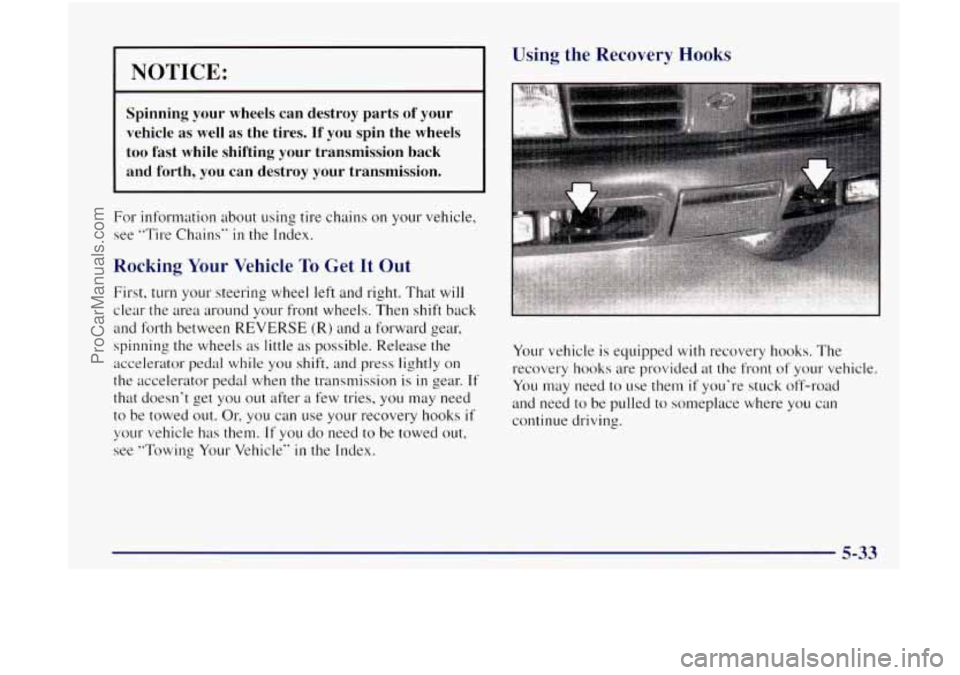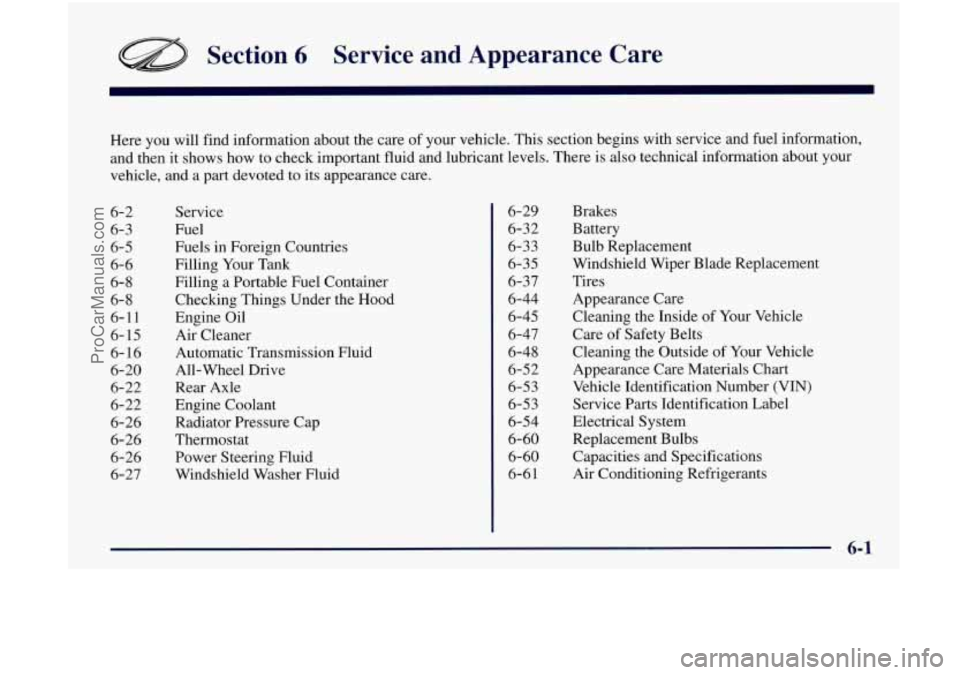steering wheel OLDSMOBILE BRAVADA 1998 Owner's Manual
[x] Cancel search | Manufacturer: OLDSMOBILE, Model Year: 1998, Model line: BRAVADA, Model: OLDSMOBILE BRAVADA 1998Pages: 380, PDF Size: 19.2 MB
Page 202 of 380

Following Distance Making Turns
Stay at least twice as far behind the vehicle ahead as you
would when driving your vehicle without a trailer. This
can help you avoid situations that. require heavy braking
and sudden turns.
Passing
You’ll need more passing distance up ahead when
you’re towing
a trailer. And, because you’re a good deal
longer, you’ll need
to go much farther beyond the
passed vehicle before you can return to your lane.
Backing Up
Hold the bottom of the steering wheel with one hand.
Then, to move the trailer to the left, just move that hand
to the left.
To move the trailer to the right, move your
hand to the right. Always back up slowly and, if
possible, have someone guide you.
NOTICE:
Making very sharp turns while trailering could
cause the trailer
to come in contact with the
vehicle. Your vehicle could be damaged. Avoid
making very sharp turns while trailering.
When you’re turning with a trailer, make wider turns than
normal.
Do this so your trailer won’t strike soft shoulders,
curbs, road signs, trees or other objects. Avoid jerky or sudden maneuvers. Signal well
in advance.
Turn Signals When Towing a Trailer
When you tow a trailer, your vehicle has to have extra
wiring and a heavy-duty turn signal flasher (included
in
the optional trailering package).
The arrows on your instrument panel will flash
whenever you signal
a turn or lane change. Properly
hooked up, the trailer lamps will also flash, telling other
drivers you’re about to
turn, change lanes or stop.
4-50
ProCarManuals.com
Page 215 of 380

/i CAJTION:
To help avoid injury to you or others:
Never let passengers ride in a vehicle that is
Never tow faster than safe or posted speeds.
Never tow with damaged parts not
Never get under your vehicle after it has
Always use separate safety chains on each
Never use J-hooks. Use T-hooks instead.
being
towed.
fully secured.
been lifted by the tow truck.
side when towing a vehicle.
A vehicle can fall from a car carrier if it isn’t
adequately secured. This can cause a collision,
serious personal injury and vehicle damage. The
vehicle should be tightly secured with chains or
steel cables before it is transported.
Don’t use substitutes (ropes, leather straps,
canvas webbing, etc.) that can be cut by sharp
edges underneath the towed vehicle. Always use
T-hooks inserted in the T-hook slots. Never use
J-hooks. They will damage drivetrain and
suspension components.
When your vehicle is being towed, have the ignition key
turned
to the OFF position. The steering wheel should
be clamped in a straight-ahead position with a clamping
device designed for towing service.
Do not use the
vehicle’s steering column lock for this. The transmission
should be in NEUTRAL (N). The parking brake should
be released.
5-9
ProCarManuals.com
Page 228 of 380

If a Tire Goes Flat
It’s unusual for a tire to “blow out” while you’re driving,
especially if
you maintain your tires properly. If air goes
out of
a tire, it’s much more likely to leak out slowly.
But if you should ever have
a “blowout,” here are a few
tips about what to expect and what to do:
If a front tire fails, the flat tire will create a drag that
pulls the vehicle toward that side. Take your foot off the
accelerator pedal and grip the steering wheel
firmly.
Steer to maintain lane position, and then gently brake to
a stop well out of the traffic lane.
A rear blowout, particularly on a curve, acts much like a
skid and may require the same correction you’d use in a
skid. In any rear blowout, remove your foot from the
accelerator pedal. Get the vehicle under control by
steering the way you want the vehicle to go. It may be
very bumpy and noisy, but you can still steer. Gently
brake to
a stop -- well off the road if possible.
If a tire goes flat, the next part shows how to use your
jacking equipment to change
a flat tire safely.
Changing a Flat Tire
If a tire goes flat, avoid further tire and wheel damage
by driving slowly to
a level place. Turn on your hazard
warning flashers.
Changing a tire can cause an injury. The vehicle
can slip off the jack and roll over you or other
people. You and they could be badly injured.
Find
a level place to change your tire. To help
prevent the vehicle from moving:
1. Set the parking brake firmly.
2. Put the shift lever in PARK (P).
3. nrn off the engine.
To be even more certain the vehicle won’t move,
you can put blocks at the front and rear of the
tire farthest away from the one being changed.
That would be the tire on the other side of the
vehicle, at the opposite end.
The following steps will tell you how to use the jack and
change
a tire.
5-22
ProCarManuals.com
Page 239 of 380

NOTICE:
Spinning your wheels can destroy parts of your vehicle as well as the tires. If you spin the wheels
too fast while shifting your transmission back
and forth, you can destroy your transmission.
For information about using tire chains on your vehicle,
see "Tire Chains"
in the Index.
Rocking Your Vehicle To Get It Out
First, turn your- steering wheel left and right. That will
clear the area around
your front wheels. Then shift back
and forth between
REVERSE (R) and a forward gear,
spinning the wheels as
little as possible. Release the
accelerator pedal while you
shift, and press lightly on
the accelerator pedal when the transmission is in gear. If
that doesn't get you out after a few tries, you may need
to be towed out. Or, you can use your recovery hooks
if
your vehicle has them. If you do need to be towed out,
see "Towing Your Vehicle''
in the Index.
Using the Recovery Hooks
Your vehicle is equipped with recovery hooks. The
recovery
hooks are provided at the front of your vehicle.
You may need to use them
if you're stuck off-road
and need to be pulled to someplace where you can
continue driving.
5-33
-
ProCarManuals.com
Page 243 of 380

Section 6 Service and Appearance Care
Here you will find information about the care of your vehicle. This section begins with service and fuel information,
and then it shows how to check important fluid and lubricant levels. There is also t\
echnical information about your
vehicle, and a part devoted to its appearance care.
6-2
6- 3
6-5
6-6
6-8
6-8
6-11
6- 15
6- 16
6-20
6-22
6-22
6-26
6-26
6-26 6-27 Service
Fuel
Fuels in Foreign Countries
Filling Your Tank
Filling a Portable Fuel Container
Checking Things Under the
Hood
Engine Oil
Air Cleaner
Automatic Transmission Fluid
All-Wheel Drive
Rear Axle
Engine Coolant Radiator Pressure Cap
Thermostat
Power Steering Fluid
Windshield Washer Fluid
6-29
6-32
6-33
6-35
6-37
6-44
6-45
6-47
6-48
6-52
6-53
6-53
6-54
6-60 6-60
6-6
1
Brakes
Battery
Bulb Replacement
Windshield Wiper Blade Replacement
Tires Appearance Care
Cleaning the Inside of Your Vehicle
Care
of Safety Belts
Cleaning the Outside of Your Vehicle
Appearance Care Materials Chart
Vehicle Identification Number (VIN)
Service Parts Identification Label
Electrical System
Replacement Bulbs
Capacities and Specifications
Air Conditioning Refrigerants
ProCarManuals.com
Page 371 of 380

Passing ....................................... 4-12
Passlock
TM .................................... 2- 1 1
Payload ....................................... 4-44
Power Periodic Maintenance Inspections
.................. 7-43
Accessory Outlets
............................ 2-45
DoorLocks
................................... 2-5
Remote Control Mirror
........................ 2-36
Seat
......................................... 1-2
Steering
..................................... 4-9
Steering
Fluid ................................ 6-26
Windows
................................... 2-25
Pregnancy. Use of Safety Belts
.................... 1 - 19
Problems
on the Road ............................ 5- 1
Publications. Service and Owner ................... 8- 10
Radiator. Adding Coolant ....................... 5- 19
Radiator Pressure Cap ........................... 6-26
Radio Reception
................................ 3-20
Radios
Cassette Tape and Compact Disc Player
........... 3- 12
Cassette Tape Player ........................... 3-8
Cassette Tape Player Care ................. 3-2 1. 7.39
Theft-Deterrent Feature
........................ 3- 17
Rain. Driving
.................................. 4-30
RAP
......................................... 2-13
Rear Axle
....................................... 6-22
Door Security
Locks ........................... 2-5
Safety Belt Comfort Guides
..................... 1-30
Seatpassengers .............................. 1-26
Seats
........................................ 1-6
Towing
..................................... 5-12
Window Defogger ............................. 3-7
Window WasherNiper
........................ 2-29
Rearview Mirror ................................ 2-35
Reclining Front Seatbacks
......................... 1-4
Recommended Fluids and Lubricants .......... 6.S1, 7.45
Recovery
Hooks ................................ 5-33
Recovery Tank. Coolant
.......................... 5-16
Replacement
Bulbs
...................................... 6-60
Parts
....................................... 6-60
Wheel
...................................... 6-43
Reporting Safety Defects
.......................... 8-8
Restraints Check
................................. 1-5 1. 7.40
Child
....................................... 1-37
Head
........................................ 1-6
Replacing Parts After
a Crash ................... 1-51
Retained Accessory Power
........................ 2-13
Reverse ....................................... 2-17
Right Front Passenger Position
.................... 1-20
Roadside Assistance .............................. 8-5
Rocking Your Vehicle ........................... 5-33
Rotation. Tires
................................. 6-39
Safety Belts
................................... 1-7
Care
....................................... 6-47
Center Rear Passenger Position
.................. 1-32
Children
............................... 1-34, 1-43
Driver Position
............................... 1-13
Extender
.................................... 1-51
How to Wear Properly
......................... 1-13
LapBelt
.................................... 1-33
Adults
...................................... 1-13
9-7
. . -~ .. .
ProCarManuals.com
Page 372 of 380

Safety Belts (Continued)
Lap-Shodder
........................... 1 . 13. 1-27
Questions and Answers
........................ I . 12
Rear Comfort Guides .......................... 1-30
Rear Seat Passengers
.......................... 1-26
Replacing After a Crash
........................ 1-5 I
Right Front Passenger Position .................. 1-20
Use During Pregnancy
......................... I - IC)
WhyTheyWork ............................... 1-8
Safety Defects. Reporting
......................... 8-8
Safety Warnings and Symbols ....................... 111
Scheduled Ma~ntenance Services .................... 7-4
Seats and Restraint Systems
........................ I - 1
Second Gear ................................... 2- 18
Security Warning Light
.......................... 2-6 1
Service 4WD Light ............................. 2-61
Service and Owner Publications ................... 8- 10
Service Engine Soon Light
....................... 2-58
Service Parts Identificatlon Label
.................. 6-53
Service Work
. Doing Your Own .................... 6-2
Servicing Your
Air Bag-Equipped Vehicle ........... 1-25
Sheet Metal Damage ............................ 6-50
Shifting
....................................... 2-16
Into Park .................................... 2-20
OutofPark .................................. 2-22
Signaling Turns
................................ 2-27
SIR .......................................... 1-20
Skidding
...................................... 4-14
Specifications and Capacities
................. 6-60. 6-6 1
Speech Impaired. Customer Assistance ............... 8-4
Speedometer
................................... 2-52
Safety
Chains
.................................. 4-48
...
Seatback. Reclining Front ......................... 1-4
Service and Appearance Care ...................... 6- 1
Stains. Cleaning ................................ 6-46
Starter Switch Check ............................ 7-41
Starting Your Engine
............................ 2-14
Steam ........................................ 5-13
Steering
....................................... 4-9
In Emergencies ............................... 4- IO
Power ....................................... 4-9
Wheel. Tilt .................................. 2-26
Storage Compartments ........................... 2-37
Storage. Vehicle
................................ 6-33
Storing
a Flak or Spare Tire and Tools ............... 5-30
Stuck:
In Sand. Mud . Ice or Snow .................. 5-32
Sun
Visors .................................... 2-44
Sunglasses Srorage
.............................. 2-40
Sunroof ....................................... 2-45
Supplemental Infla~able Restraint
.................. 1-20
Symbols. Vehicle .................................. v
Tachometer .................................. 2-52
Taillamp Bulb Replacement
....................... 6-34
Tape Player Care
.......................... 3-21. 7-39
Temperature Display
............................ 2-38
Thefl
......................................... 2-10
THEFTLOCK
............................... 3-17
Thernlostat
.................................... 6-26
Third Gear
.................................... 2-18
Tilt Steering Wheel
............................. 2-26
Time. Setting
................................... 3-7
Tire Chains
.................................... 6-44
Ti re.s
Alignment and Balance
........................ 6-43
Buyins New ................................. 6-40
Changlng a Flat
.............................. 5-22
ProCarManuals.com